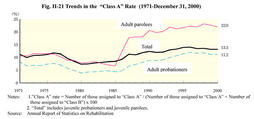| Previous Next Index Image Index Year Selection | |
|
|
3. Other measures (1)Classified treatment system
Classified treatment is a system whereby probationers and parolees are divided into"Class A"or"Class B"depending on the difficulty of their treatment under certain criteria in line with scientific views. Under this scheme, "Class A"probationers and parolees who are judged to have a number of problems and to be difficult to treat shall receive direct and positive treatment by probation officers. Fig. II-21 shows the trends in the rate of parolees and probationers who were assigned to"Class A"since the classified treatment system started in 1971. Fig. II-21 Trends in the"Class A"Rate (1971-December 31, 2000) In recent years, the rate of"Class A"has been increasing for both adult parolees and adult probationers, which shows that the number of parolees and probationers who were difficult to treat was increasing in comparison with the past. However, the rate has been almost flat since 1995.(2)Categorized treatment system Categorized treatment is a system whereby the problems and other characteristics of probationers and parolees are divided into 10 categories according to the nature of the crime or delinquency, environmental conditions and other circumstances. Concrete treatment guidelines are set for each category and treatment is implemented focusing on these characteristics. Probationers and parolees who fall under more than one category shall be assigned to more than one category and subject to corresponding types of treatment. As of December 31, 2000, 27.2% of adult parolees and 22.3% of adult probationers were assigned to the"Stimulant drug offense"category, 3.5% and 4.6% to the"Connection to organized crime groups"category, and 4.8% and 4.3% to the"Sexual offense"category respectively (Rehabilitation Bureau, Ministry of Justice). (3)Probationary supervision for long-term sentenced parolees Special measures to enhance and reinforce probationary supervision are taken for long-term sentenced parolees including life-sentenced parolees (see Section 2, 3 (2) of this Chapter for parole examinations for long-term sentenced inmates). Such long-term sentenced parolees shall be accommodated in halfway houses for a month from the beginning of parole, if such treatment is deemed to be reasonable for them by the Regional Parole Board and they give their consents. This intermediate treatment, whose purpose is to enable them to have a prompt and smooth return to life in the society is implemented in a planned and concentrated manner. In 2000, 116 parolees were subject to intermediate treatment (Rehabilitation Bureau, Ministry of Justice). In July 2000, a new treatment scheme started focusing on the one year after the release on parole (or the period of parole if it is shorter than one year)as the key treatment period during which direct participation by probation officers are reinforced. Furthermore, other treatments started to be implemented such as continuing to provide guidance and advice from the commencement of probationary supervision with regard to specific means to pay compensation for damage or consolation money to victims and bereaved family members of deceased victims. |
